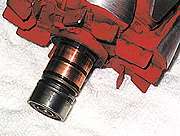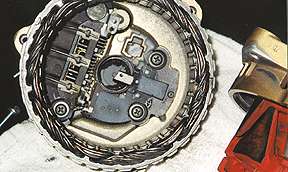In the September 2001 issue of Wing World, we reviewed the 80+ alternator marketed by Simpro as "designed for the GL1500."
We had obtained this unit directly from Simpro, put it on our '99 GL1500 SE, and tested it for voltage and current output as well as ease of installation. It has rendered good service since
then, and so we had no reason to disassemble the unit or test it further. Simpro has a well-earned reputation for producing good quality electrical motorcycle accessories. Their 80+
alternator does not live up to that reputation in many cases, and we take issue with the methods used to market that product.
In the months since our initial testing. We've heard
complaints arising from the use of the Simpro 80+ alternator including vibration, oil leakage, and even complete electrical failure. We contacted Simpro for an explanation and were told the
following.
The original design of the drive coupling was such that the coupling rattled in the rubber dampers within the rear engine case. The coupling has since been redesigned.
Simpro specified a certain type of rubber when ordering oil seals for the front end-frame. The seals provided by Simpro's vendor were not of the specified material and were prone to
failure. Correct seals are now being installed.
Some of the rectifier/regulator units were failing, but the vendor for that piece has been changed, and the problem has been corrected
in current production units.
Unfortunately, a number of these alternators that apparently were produced prior to the running production changes are still in the hands of vendors or are
installed on motorcycles in use.
One of these units failed here in Arizona, and a replacement proved to be no better. "Excessive vibration" was the chief complaint. After one repair
shop failed to correctly diagnose the problem, an independent motorcycle mechanic replaced the Simpro alternator with a stock Honda unit. The vibration instantly vanished. He then installed
the Simpro unit on another GL1500, and the vibration appeared on that second bike.
Suspecting that the Simpro alternator was somehow causing vibration, the mechanic took the
alternator to an auto-electric service for inspection. The service determined that the alternator had lost one phase of its three-phase output. The service then opined that the alternator
was not new or even almost-new. 
Note heavy spray paint on rotor. 
Note carbon dust in bearing bore. 
Note stripped threads on third bolt. Concerned by the suggestion that the Simpro was a used piece, we called Simpro's Mike Schroeder.
After discussing the various failure modes of the alternator with Mike, we asked him whether his 80+ alternator was of all-new manufacture or not. His answer was,
"they're old units." Without disclosing the exact source, he further explained that the old units were adapted to fit the GL1500 engine.
The next day, we disassembled a
"new in box" Simpro 80+ alternator to ascertain its condition. What we found verified our suspicions. The three screws that hold the end frames to the stator frame are
cross-headed screws with an 8mm hex. The screwdriver slots on one of these screws were packed with greasy filth. Upon removal of the screws, corrosion was evident on
their shanks, and the threads of one were partially stripped.
Separation of the end frames revealed corrosion on the outside diameter of the rear bearing. The
bearing had some axial play and some lubricant leakage from the integral seals. The bottom of the bearing bore was packed with what appeared to be a combination of
carbon brush dust and grease. The brushes appeared to have had significant use.
The rotor had been completely covered in flat-red spray paint. The end poles had then been wiped
clean to give the appearance of a new part. The slip rings appeared to have been reconditioned, but the brushes were making only partial contact.
The stator frame and windings had
been spray painted a color that simulated steel, but a scrape of the fingernail revealed rust underneath. This paint wasn't limited to the frame and windings on this
particular example. The regulator, rectifier, and heat sink were also covered with spray paint, no doubt resulting in overheated components that have failed in the field. A close
examination of the solder joints that attached this particular regulator leads us to conclude that it is the original regulator with which this alternator was equipped. A
second "new" unit appeared to have had its regulator, rectifier, and heat sink replaced. Those items on this second example were free of paint with crisp, new looking labels, even
though the stator frame and windings were paint covered.
vThe overall internal condition of the alternator left no doubt that it was indeed a used unit, modified with a
new front end frame to match the bolt pattern on the GL1500 engine. Since an aluminum-bodied alternator visibly ages with use, the contrasting appearance of the new
front, rusty middle, and used looking rear would have been obvious. Gold-colored spray paint took care of that but created another problem; the paint prevented the alternator
from making electrical contact with the engine case. Therefore, the paint had to be scraped from the mounting points before the unit would function correctly.
When purchasing an auto-electric product such as this for our cars, we have the choice of new or rebuilt. New costs roughly twice as much as rebuilt, but we have good reason to
believe that the brand new product will provide longer service. We buy rebuilt product when finances dictate. The point is that we believe we know what we're getting for the
money regardless of which alternative we choose.
In the case of the Simpro 80+ alternator that we examined, much time, effort, and spray paint was expended in an attempt to conceal
the fact that the product wasn't new (aside from the front end-frame). If it weren't for the front portion, it wouldn't even qualify as "rebuilt." "Refurbished" is
a more appropriate description. The interior of the unit we inspected hadn't even been thoroughly cleaned!
When we pay for what we reasonably assume to be new product, we don't expect to be
paying for filth and used components! When we see a product advertised with no disclaimers, we assume that it is new – one hundred percent new. Remanufactured or
reconditioned product should always be identified as such; to neglect to do so is outright misrepresentation.
Based on the problems we've heard of and confirmed for ourselves as
well as what we consider to be misrepresentative marketing, we suggest that Members consider alternatives to the Simpro 80+ when shopping for a high output alternator for the GL1500. In our
opinion, there are better values to be had.—Stu Oltman Ed. Note: An attorney representing Simpro has demanded this article be
withheld from publication.
Wing World has re-affirmed its contents through further testing of other Simpro units and we stand behind the findings of this story.
PREVIOUS PAGE   NEXT PAGE
NEXT PAGE |